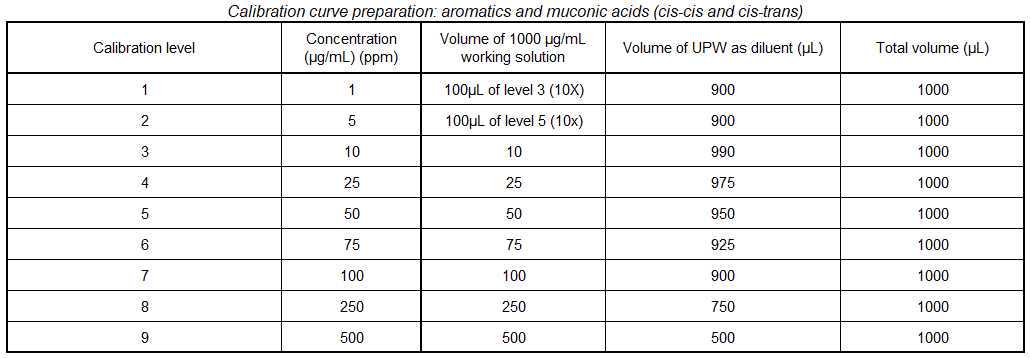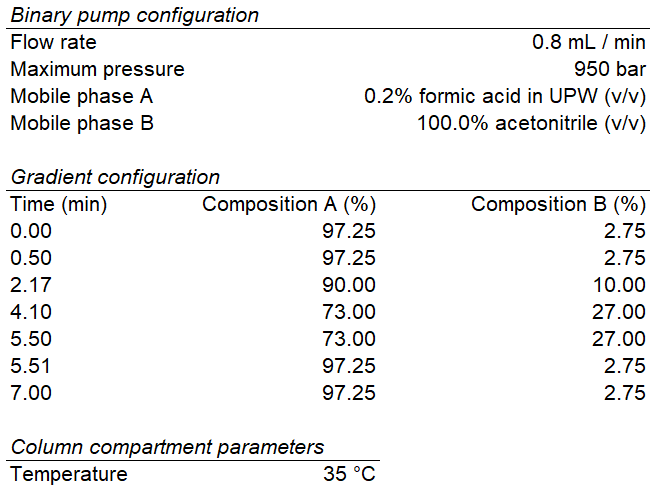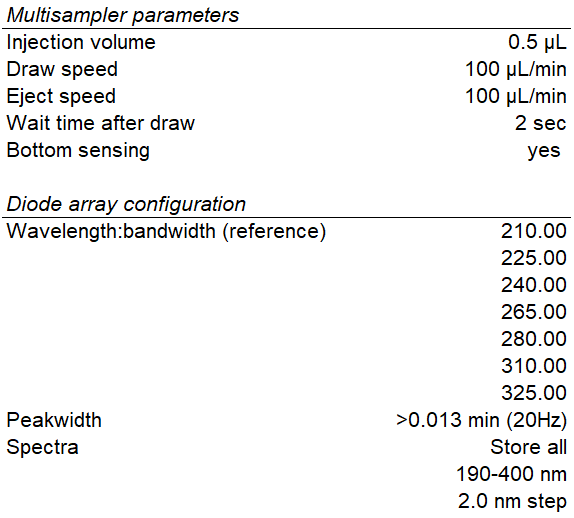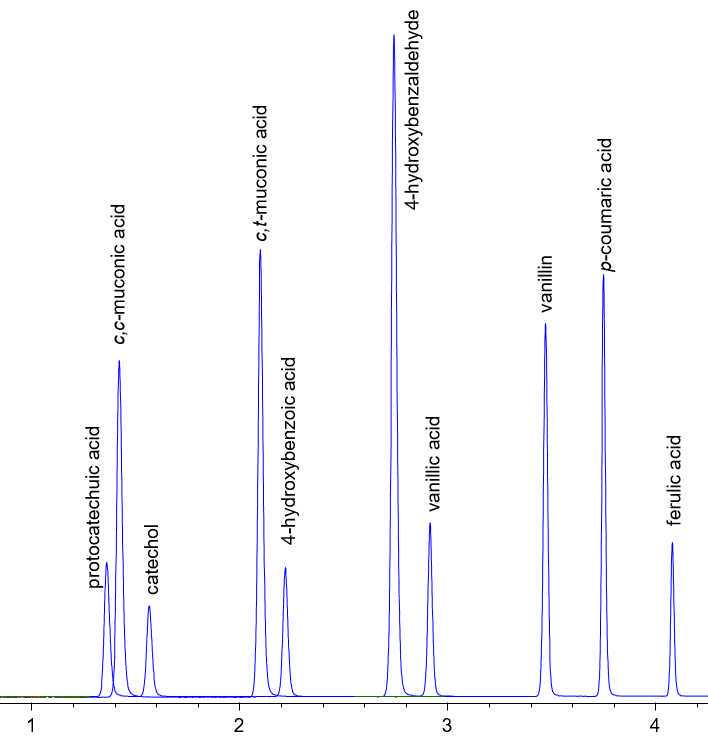Muconic acid isomers and aromatic compounds analyzed by UHPLC-DAD
Gregg T. Beckham, Kelsey J. Ramirez, Stefan J. Haugen, Sean P. Woodworth, William E. Michener
muconic acid
aromatic acids
isomers
kinetex
c18
gradient
UHPLC
DAD
lignin
lignin aromatics
lignin-derived aromatics
lignin-derived aldehydes
lignin-derived carboxylic acids
Disclaimer
This protocol is for research purposes only.
Abstract
An analysis method was developed to allow for quantitation of muconic acid isomers ( cis, cis and cis, trans ) and aromatic compounds by ultra high pressure liquid chromatography paired with diode array detection (UHPLC-DAD). This was achieved by reproducible preparation of c,c and c,t isomers of muconic acid and chromatographic separation using a mobile phase gradient to separate various aromatic analytes and muconic isomers on a UHPLC reverse phase analytical column.
Before start
All solvents and chemicals used are listed in the ‘Materials’ section. These are excluded from in-line references to maintain clarity and keep the steps concise.
Steps
Preparation of Mobile Phases
Mobile Phases
- To make the aqueous 0.2% formic acid, dilute 2.0 mL of formic acid into 1.0 L of 18.2MΩ⋅cm ultrapure water (UPW). Volumetric preparation is optimal.
- Acetonitrile is used as the organic mobile phase.
Preparation of Standards
Standards
This procedure for standard preparation is previously documented in our work published as the National Renewable Energy Laboratory (NREL) Laboratory Analytical Procedure (LAP) 'Determination of cis,cis-and cis,trans-Muconic Acid from Biological Conversion' (https://www.nrel.gov/docs/fy19osti/74473.pdf). Preparation of both cis,cis - and cis,trans -muconic acid isomer standard solutions are outlined in LAP sections 10.1.3 and 10.1.4 and below in protocol step 2.1. Both standard working solutions of c,c and c,t isomers of muconic acid are prepared at 1 g/L concentrations in 0.05% v/v sodium hydroxide solution (preparation of sodium hydroxide is outlined in the referenced LAP, section 10.1.2 and below in step 2.1). Each muconic acid isomer is to be prepared in separate calibration curves in subsequent steps, the isomers should not be combined due to the tendency for c,c to irreversibly isomerize to c,t -muconic over time at room temperature.
The LAP uses the following acronyms:
c,c -muconic acid ( cc MA)
c,t -muconic acid ( ct MA)
10.1.2 from LAP
Prepare a sodium hydroxide solution (0.05% v/v) for standard preparation. Prepared by adding 66 μL 10N sodium hydroxide with an air displacement pipette to 39.934 mL of UPW measured using a repeater pipette. This solution may be scaled if necessary.
10.1.3 from LAP
Prepare the cc MA stock standard by weighing 40.0 ± 0.5 mg of the cc MA standard into a 40 mL amber vial and record the weight of the standard to the nearest 0.1 mg. Add an appropriate volume of 0.05% v/v sodium hydroxide solution using a repeater pipette to make a final concentration of exactly 1.0 mg/mL solution and mix well (vigorous shaking periodically over approximately 1 hour to allow for solubilization). The muconic acid should be completely dissolved before use otherwise the concentration of the standard will be unknown. Record the date of preparation, concentration, and any other pertinent information on the vial and store sealed at 4 °C for up to 4 months (stability study ongoing).
10.1.4 from LAP
Prepare the ct MA stock standard by preheating a water bath to 60 ± 3 °C. Weigh exactly 40.0 mg of the cc MA standard into a 40 mL amber vial (vial REQUIRED as ordered per Step 7.2.1; vial variation will lead to heat transfer difference and the reaction time will either lead to incomplete ct MA formation or lactone formation). Record the weight of the standard to the nearest 0.1 mg. Add 39.934 mL UPW or similar using a repeater pipette and mix well. Record the concentration of the standard, date of preparation, and any other pertinent information on the vial. Seal the standard with compatible vial top and place into the water bath so that the liquid in the vial is completely submerged for 2 hours. Shake every 15 minutes (use personal protective equipment as necessary). After 2 hours, immediately add 66 μL of 10 N sodium hydroxide using an air displacement pipette and mix. Store the sealed vial at 4 °C for up to 4 months (stability study ongoing).
Additionally, aromatic analytes compatible with this method are listed in the 'Materials' section.
Preparation of aromatic analyte standard stocks should be performed in a compatible solvent for compound solubility. A 1 g/L concentration ampule of Aromatics Mix Large Rev.1 (detailed in 'Materials') is used and diluted in UPW to reach relevant calibration curve concentrations.
Calibration Curve

Preparation of Samples
Samples
- All samples containing muconic acid require a minimum 5x dilution scheme (4:1 diluent to sample ratio) for reliable quantitation of isomers due to matrix effects causing chromatographic issues. Compounds included in the aromatic mix do not require dilution without the presence of muconic acid.
- Samples must be filtered through a 0.2 µm or smaller filter prior to injection on the UHPLC.
- Samples expected to be over the linear range of the instrument should be further diluted to be within the calibration range to ensure accurate analysis and avoid carryover.
UHPLC-DAD Analysis
Method Specifications
Analysis of muconic acid isomers and aromatics is performed using an Agilent 1290 series ultra high performance liquid chromatography (UHPLC) system with a diode array detector (DAD). Complete method parameters are in the tables below.


Use the analytical column listed here, as well as associated guard column phase (with associated holder) listed in 'Materials'.
Equipment
| Value | Label |
|---|---|
| Kinetex | NAME |
| reverse phase analytical column | TYPE |
| Phenomenex | BRAND |
| 00D-4475-AN | SKU |
| 1.7 µm / 100 x 2.1 mm / 100 Å | SPECIFICATIONS |
Analytical Quality Control
Multiple strategies are utilized when performing this analysis to ensure instrument stability and reproducibility.
Calibration Curves
A minimum of 5 standard levels should be used.
All compounds must have a correlation coefficient (r2) of 0.995 or greater using a linear calibration fit and ignoring the origin.
Calibration Verification Standards (CVS)
A calibration verification standard (CVS) is a standard from the calibration curve that is re-injected every 20 or fewer samples to ensure instrument drift remains within the determined acceptance criteria. Acceptable CVS recoveries for this analysis are within 10% of the expected amount. Acceptance criteria may differ between instruments and should be determined experimentally.
Example Chromatography
Data Reporting
Muconic acid should be reported as a sum of the two isomers. While isomerization from c,c -muconic to c,t -muconic is irreversible, environmental conditions (decreased pH, exposure to heat, etc.) may cause further isomerization of c,c -muconic acid to c,t -muconic acid. This will cause a change in the ratios of these isomers but the total muconic acid concentration will remain constant. Discrepancies in data are avoided by reporting the total of c,c -muconic acid plus c,t -muconic acid as a sum of the isomers.


